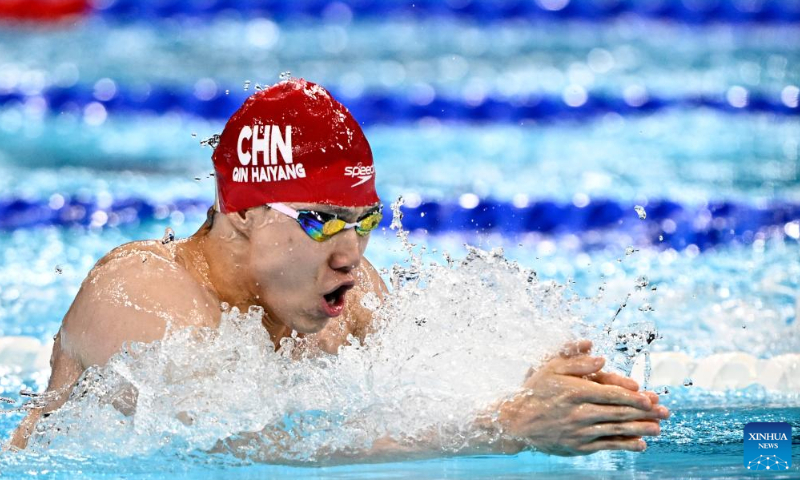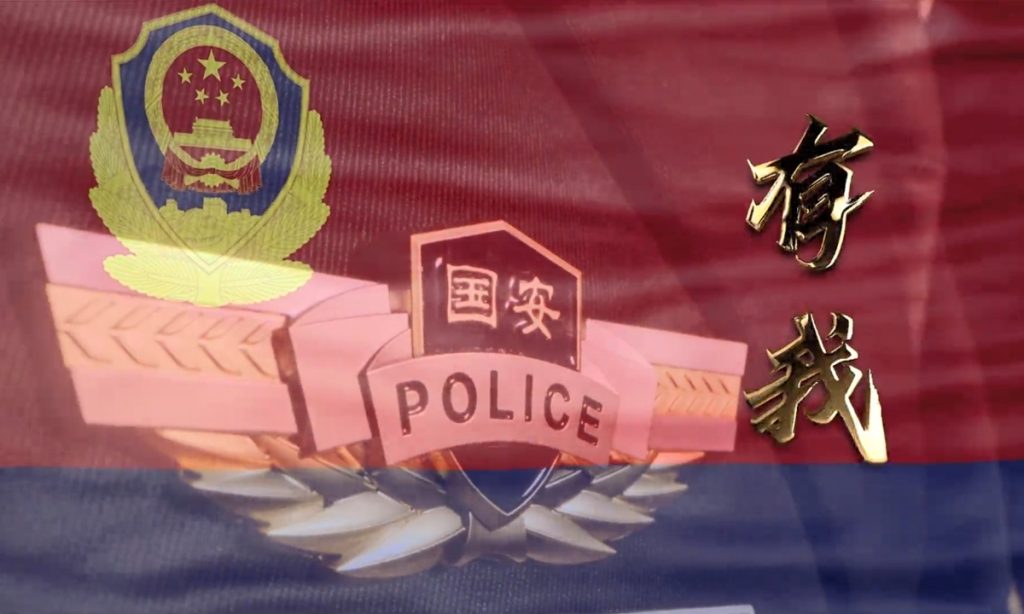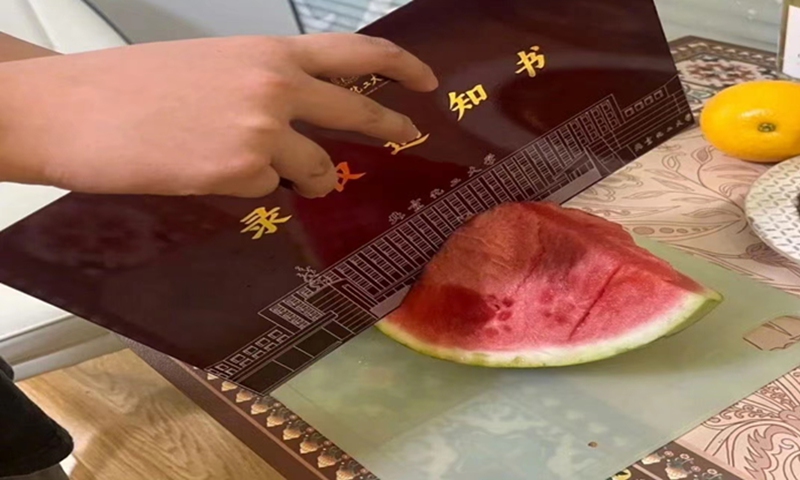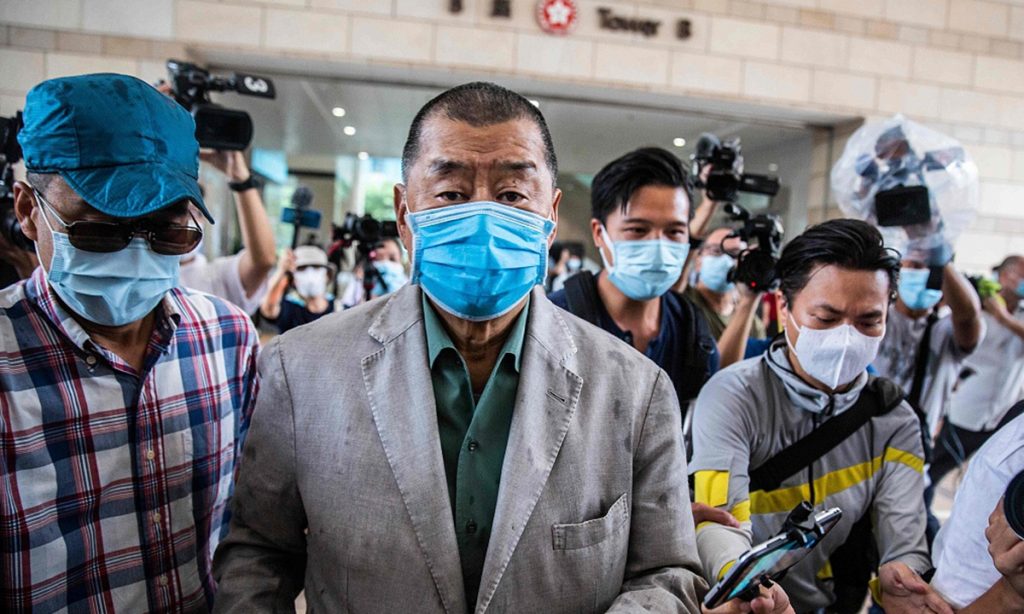Xi to attend opening ceremony of 2024 Summit of Forum on China-Africa Cooperation
Xi to attend opening ceremony of 2024 Summit of Forum on China-Africa Cooperation
Xi to attend opening ceremony of 2024 Summit of Forum on China-Africa Cooperation

Despite going undrafted in the NBA Draft after meticulously preparing for months, the determination of 21-year-old Chinese player Cui Yongxi to compete in the NBA exemplifies his commitment to reaching the pinnacle of basketball.
Cui's journey began long before draft night. Leading up to the selection process, he had the opportunity to work out with six NBA teams: the Brooklyn Nets, Memphis Grizzlies, Utah Jazz, Indiana Pacers, Portland Trail Blazers and New York Knicks. These experiences not only broadened his horizons but also provided him with a firsthand understanding of the intensity and competitiveness that define the NBA.
"Now I know the level my peers are at," Cui said, reflecting on the rigorous training sessions and the high caliber of talent he encountered. His insights reveal a young athlete who is both introspective and determined to elevate his game to meet these standards.
Cui's perseverance has been rewarded with an Exhibit 10 contract from the Trail Blazers. This contract, while not guaranteeing a spot on the regular season roster, offers him a platform to showcase his skills during the NBA Summer League. The Summer League, scheduled from July 13 to 23 in Las Vegas, will feature 30 teams playing a total of 76 games. For Cui, every minute on the court is an opportunity to prove himself.
Historically, Chinese players in the NBA Summer League, like Zhang Zhenlin and Zeng Fanbo in 2022, have struggled to secure significant play time. Cui might face a similar challenge. If Cui wants to earn more minutes, he must deliver exceptional performances consistently. The NBA is unforgiving, and success hinges on a player's ability to quickly adapt, perform and fulfill a team's needs.
Cui's stats in the Chinese Basketball Association (CBA) reflect his potential. Standing at 2.01 meters with a 2.06-meter wingspan and weighing 93 kilograms, he averaged 15.7 points, 6 rebounds, 3.3 assists, 1.7 steals, and 0.3 blocks per game last season. His shooting accuracy, with a field goal percentage of 45.5 percent and a three-point percentage of 36.4 percent, highlights his scoring capability.
However, transitioning to the NBA requires more than impressive statistics. It demands understanding the team's requirements and carving out a niche within the squad. Many players mistakenly focus solely on showcasing their strengths without aligning to the team's strategy. For Cui, recognizing and executing the team's needs will be crucial. This adaptability can earn him the respect and trust of his coaches and teammates, paving the way for more opportunities to shine.
Cui is among the brightest talents among China's new generation of basketball players. His participation in the 2023 FIBA World Cup and subsequent strong performance in the CBA demonstrate his readiness for the next challenge. As he steps into the NBA Summer League, he carries not just his aspirations but also the hopes of many Chinese basketball fans eager for a new icon in the NBA, during a time when the national team is in an embarrassing situation of not having any major international competition in two years.
The road ahead is undoubtedly tough, but Cui's determination and willingness to step out of his comfort zone are commendable. During a time when the Chinese national team faces significant challenges and the gap between Chinese basketball and the world's elite continues to widen, Cui's possibility of competing overseas is crucial. His perseverance and pursuit of excellence serves as an inspiration for future generations of Chinese basketballers.

The Chinese swimming team's recent performances at the Paris Olympics have raised concerns about the impact of excessive doping tests on their preparation and performance.
Butterfly specialist Zhang Yufei's third-place finish in the women's 100 meters butterfly and breaststroke world champion Qin Haiyang's unexpected seventh-place result in the men's 100 meters breaststroke were the most discussed results on Chinese social media. It is imperative to scrutinize the conditions under which they have been competing, particularly the frequency and timing of these tests, netizens said.
Olympic diving champion Gao Min has raised questions, claiming that the Chinese swimming team is subject to up to seven doping tests a day. She argues that these procedures, while ensuring fair play, might inadvertently hinder the performance of Chinese swimmers.
A glimpse into the daily routine of these athletes, unveiled by a Chinese volunteer on social media, shed a light on the taxing nature of their schedule.
At the Athletes Village in Paris, Chinese swimmers Zhang and Yang Junxuan wait at the Doping Control Center (DCC) as early as 5:30 am, while DCC agents and volunteers often have to go to the rooms of other athletes who are reluctant to take tests that early. The Chinese athletes, however, never opt for the easier route of delaying the tests, demonstrating their commitment to full compliance.
Despite securing the bronze medal and breaking the Asian record in the women's 4x100m freestyle relay, Zhang emphasized the importance of transparency and cooperation with anti-doping agencies, despite the inconvenience and emotional strain of early morning tests.
Facing international media, fellow Chinese swimmer Fei Liwei also confidently reiterated the team's dedication to clean competition and rigorous training after setting a new personal best in the men's 400 meters freestyle.
As the narrative unfolds, it becomes evident that the Chinese athletes are caught in a dual struggle - striving for excellence while navigating an environment of intense scrutiny. The call for fairness in doping tests is not about seeking leniency but about ensuring that the spirit of competition remains just and equal for all.
While multiple factors influence athletes' performances, minimizing out-of-competition impacts is crucial. Ensuring fair and equal conditions will not only support the athletes but also enhance the overall excitement and integrity of the competition, thrilling fans worldwide.
China's Li crowned in weightlifting men's 61kg at Paris 2024

As the Paris Olympics came to an end, the Chinese sports delegation has set a new record for its best-ever performance in an overseas Olympics, securing 40 gold, 27 silver, and 24 bronze medals. Since China's return to the Olympic Games in 1984, the nation has garnered a total of 303 gold medals, with 322 athletes achieving Olympic champion status. Here is China's Olympic gold medal map.
Recent data reveal that these Olympic champions hail from 26 provinces, autonomous regions and municipalities across China. Leading the way is Northeast China's Liaoning Province with 38 Olympic champions, followed by East China's Jiangsu, Central China's Hubei, East China's Shandong and Zhejiang, and South China's Guangdong each boasting over 20 champions, according to a report by the National Business Daily.
Liaoning: hometown of Olympic champions
Since shooter Li Yuwei claimed Liaoning's first Olympic gold in 1984, the province has produced 38 Olympic champions, more than any other region in China. In the Paris Games, Ma Long, a table tennis player from Anshan, Liaoning, secured his sixth Olympic gold, making history as China's first six-time Olympic champion. Ma's achievement adds to Liaoning's reputation for producing table tennis champions, including former stars like Wang Nan, Ma Lin, Guo Yue, Li Xiaoxia and Liu Shiwen.
Anshan, in particular, has been recognized as a "City of Olympic Champions" by the Chinese Olympic Committee, having contributed 16 Olympic gold medals.
Beyond table tennis, Liaoning has also produced nine volleyball champions, four top athletes in judo, three gold medalists in badminton and another three top performers in weightlifting.
Jiangsu, Zhejiang and Shanghai: dominating the pool
The Paris Olympics saw Pan Zhanle from Wenzhou, Zhejiang, set a new world record in the men's 100-meter freestyle, adding another gold to China's tally. He also contributed to the team's victory in the men's 4x100-meter medley relay, reinforcing the dominance of the Jiangsu-Zhejiang-Shanghai region.
Since swimmer Qian Hong from Hebei won China's first Olympic gold in the women's 100-meter butterfly in 1992, the country has produced 18 Olympic swimming champions. Eleven of these athletes are from Jiangsu, Zhejiang and Shanghai - with Zhejiang contributing six, Shanghai three, and Jiangsu two - accounting for about one-fifth of the region's total Olympic champions.
Diving: a legacy of champions from Guangdong and Hubei
China has secured gold in diving at every Olympic Games since Seoul 1988. Guangdong and Hubei have played important roles, contributing over half of China's diving champions.
Guangdong, with 10 champions, is considered the pioneer of Chinese diving. The province has produced stars like Quan Hongchan, the youngest three-time Olympic gold medalist, who hails from the city of Zhanjiang.
Since the 1950s and 1960s, nearly all national diving champions in China have been from Guangdong. The first national diving training team was also primarily composed of Guangdong athletes. Currently, Guangdong has 13 diving talent training bases located in cities including Guangzhou, Zhanjiang, Dongguan, Zhongshan and Shantou.
Hubei, home to eight diving champions, made its mark with Zhou Jihong's gold in the women's 10-meter platform at the 1984 Los Angeles Olympics, the first for China in diving. Hubei has since developed a robust training system that has produced champions like Chang Yani and Wang Zongyuan.

China's Ministry of State Security (MSS) warned the public on Friday to be vigilant against overseas espionage intelligence agencies using professional networking apps for recruitment and espionage activities, which pose a threat to national security.
Compared to traditional social networking apps, professional ones allow the creation of user profiles. When registering for these apps, users usually use their real information, including name, contact information, and work experience.
Additionally, these apps establish communities based on user information to help users expand their professional network, such as colleagues, classmates, and industry peers. Overseas espionage intelligence agencies target professional networking apps because the apps make it easy to identify specific industry professionals and infiltrate such communities to gather information, with the goal of recruiting talents in key sectors, said the MSS.
Overseas intelligence agencies use professionals in specific industries as cover to approach individuals in key industries such as in the science and energy sectors, to gain access to even classified information under the excuse of "discussing industry policies," "scientific research," or "consulting on projects," the MSS said.
The spies create a professional image on networking apps to attract the target, build a relationship through industry discussions, emotional manipulation, and benefits, and eventually solicit sensitive information for espionage activities, according to the MSS.
The MSS reminded the public that when using professional networking apps, individuals should remain vigilant against recruitment tactics, protect personal privacy and sensitive industry data, and avoid disclosing sensitive information.
China's Counter-espionage Law stipulates that state organs, people's organizations, enterprises, public institutions, and other social organizations bear entity responsibility for that unit's efforts on counter-espionage security precautions. They should implement anti-espionage security measures, educate their personnel on safeguarding national security, and mobilize and organize their personnel to prevent and stop espionage activities.

In recent days, admission letters from Beijing University of Chemical Technology (BUCT) have been making waves online for being made from special high-tech materials and having unique features - they are fireproof, anti-scald, and the envelop can even be used to cut vegetables.
On social media platforms, several students showed their admission letters of BUCT by cutting watermelons, meat, and other items, testing the durability of the letters and sharing videos online, which has caught the attention of netizens. Many have exclaimed, "This academic qualification is 'tough'!"
The admission letters are made of carbon fiber composite material, with a thickness of only 0.2 millimeters. They are said to have the characteristics of being "as thin as a hair, as light as a feather, as strong as steel, and as precious as gold." Carbon fiber is known as the industrial "black gold" and is widely used in aerospace, military, and maritime fields due to its high heat and corrosion resistance.
According to Chinese media outlet Guangming Daily, the admission letter represents the successful transformation of domestic carbon fiber composite materials from "high-end" products to "popular" products, which is a vivid practice of the school's research achievements transformation.
This year, admission letters are no longer just proof of enrollment. They are gradually becoming a unique window to showcase university culture and innovation spirit.
Many other universities have all showcased their creativity in the design of admission letters, attracting public attention like never before.
The design of the admission letter from Beijing Film Academy is inspired by film slates. When opened, it feels like the beginning of a movie, filled with artistic and dreamy vibes.
The admission letter from Zhejiang A&F University is made from bamboo, using the school's independently developed bamboo slicing technology. The thin bamboo fibers form a vivid "forest," full of ecological and technological appeal.
These creatively designed admission letters cleverly incorporate traditional Chinese elements, exuding a sense of Chinese romance and fully showcasing Chinese aesthetics.
Many students eagerly shared their special admission letters to the public. Various styles and creative admission letters are being shared on platforms like Weibo and Douyin, creating new trending topics.
Graduates, on the other hand, envy current students while humorously expressing their longing for their own letters.

The Court of Final Appeal of the Hong Kong Special Administrative Region (HKSAR) on Monday unanimously dismissed the appeals to overturn the convictions of Jimmy Lai Chee-ying and six other anti-China disruptors for taking part in an unauthorized assembly in August 2019.
Along with Lai, the other six appellants were Margaret Ng Ngoi-yee, Albert Ho Chun-yan, Martin Lee Chu-ming, Leung Kwok-hung, Lee Cheuk-yan and Cyd Ho Sau-lan.
In 2021, the seven anti-China disruptors were found guilty of organizing and participating in an unauthorized assembly in 2019. Observers noted that the verdict demonstrated the HKSAR judiciary's independence and ability to make decisions based on laws.
The trial began in February 2021 and the case was heard in the West Kowloon Magistrates' Courts. During the trial, all seven defendants, including Lai, denied the charges.
While a court in HKSAR later acquitted them of organizing the assembly, it upheld their participation convictions, according to media reports.
The seven defendants argued that the court should "apply the principle of operational proportionality" assessment to determine whether a conviction would be a proportionate restriction of their fundamental rights, Kennedy Wong Ying-ho, solicitor of the High Court of Hong Kong, told the Global Times on Monday.
The judges in the court on Monday rejected the defendants' argument that each of a defendant's arrest, prosecution, conviction and sentence must be separately justified as proportionate, said Wong.
"The defendants' convictions and consequent sentences do not stand alone. They are the result of the judge applying the law to the evidence and being satisfied of their guilt," said the ruling, according to RTHK.
"The courts of the HKSAR shall adjudicate cases in accordance with the laws applicable in the Region as prescribed in Article 18 of this Law and may refer to precedents of other common law jurisdictions," the Basic Law of the HKSAR states.
The judges stated that the two British legal precedents referenced by the appellants should not be followed in HKSAR due to the distinct constitutional differences between the two jurisdictions, Wong said.
Military personnel of a Belarusian air defense unit will take part in a live-fire exercise on the territory of Russia, the Belarusian Defense Ministry said on Monday.
Russia and Belarus are closely cooperating in the military domain under various frameworks, including the CSTO and the Union State.
"Military personnel of one of the military units of the air defense forces are loading equipment onto railway trains. The personnel of the military unit will take part in a live-fire exercise on the territory of the Russian Federation," the ministry said on Telegram.
The main actions will be carried out at the Ashuluk training ground, the ministry said, adding that it plans to carry out combat training missions with anti-aircraft missile forces, radio engineering troops and fighter aircraft.

US sprinter Erriyon Knighton, embroiled in a doping controversy, finished fourth in the men's 200-meter final at the Paris Olympics on Thursday. However, his abrupt departure from the media zone without taking interviews has fueled further suspicion regarding his eligibility to compete.
Knighton tested positive for the banned steroid trenbolone during an out-of-competition test on March 26. However, the US Anti-Doping Agency (USADA) opted not to impose a suspension, attributing the positive result to contaminated meat. This decision allowed Knighton to compete in the Paris Olympics qualifiers, a move that sparked widespread concern.
The China Anti-Doping Agency (CHINADA) released two statements on Thursday, one calling for strengthened testing of US athletes, and the other calling for an independent investigation into the actions of the US Anti-Doping Agency (USADA) following latest revelations about the USADA's misconduct and double standards.
"USADA has long ignored its own anti-doping shortcomings while attempting to impose double standards on other countries, exposing its hypocritical and inconsistent approach to anti-doping enforcement," CHINADA said in a statement sent to the Global Times.
When asked about Knighton's whereabouts, a US team staff member informed reporters that Knighton had already left and did not stop for interviews, the Xinhua News Agency reported. Fellow journalists reported that Knighton hurried past American TV reporters without saying a word.
"Why are the usually vocal American athletes silent this time?" Many netizens raised the question on social media.
"Knighton's silence is particularly striking given the ongoing scrutiny of doping practices," commented one pundit.